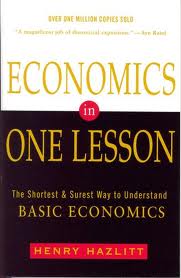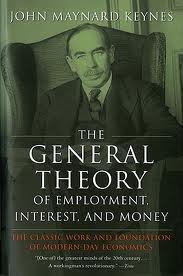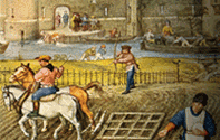To summarize this course and its topic, the following review (edited) of Hazlitt’s book is helpful. The theoretical ideas set forth by Hazlitt must inform the actions we take in order to be of any real worth.
Review of Economics in One Lesson (Source)
As part of my preparation for undertaking this book review project, I have referenced many great thinkers’ lists of books they say have influenced them. Most notably, I have consulted Tom Woods, Ron Paul, and Lew Rockwell. Without exception, these giants of economic thought recommend Economics in One Lesson by Henry Hazlitt. Taking this into account I felt inclined not only to buy and read Hazlitt’s masterpiece, but review and digest its contents thoroughly.
In a famous essay by Bastiat (of The Law fame) he mentions the “seen and the unseen”. This is a crucial distinction for economists to make if they want to make sense of the world. So crucial, in fact, that Hazlitt’s book focuses precisely on this concept. His one lesson is this: When analyzing the economy, or the effects of certain policies, we must focus not only on the short term benefits to a certain small group, but on the long run consequences on everyone.
The basic structure of this book is a series of short chapters that each follows a pattern. Hazlitt outlines an economic fallacy that we hear argued in the mainstream sphere, and how it will allegedly benefit a certain special interest group. He will then explain that this policy not only will not benefit society, but hurt it in the long run. In many cases, such as minimum wage legislation, Hazlitt proves these policies hurt even the special interest groups they were meant to help in the first place. He systematically uses his one lesson, learning to observe both the seen and the unseen, to the advantage of his argument. It would require and exhaustive work to outline each and every fallacy that Hazlitt overturns, so I will focus my review on a few I found most interesting and pertinent to the current political climate.
The Broken Window Fallacy
Say someone throws a brick into a shopkeeper’s window. Now the shopkeeper must pay, say, $250 to have his window repaired. The window repairman will now go and spend that $250 on a new set of tools, and the tool man will in turn buy a chair. Look at the economic growth created by that broken window! What we have examined thus far is merely the seen, or the immediately obvious effects of the broken window. Let us peer into the unseen. As Hazlitt argues, the shopkeeper may have been planning to spend that $250 somewhere else, let’s say on a new suit. Now, instead of having both a functional window AND a new suit, he merely has the window. Society, in turn, is one suit poorer. The crux of the matter is that although the shopkeeper spends the $250, society loses because he does not spend it on its most productive resource.
Why is the broken window fallacy so important? It relates very closely to the common argument that war is good for the economy. War, in the eyes of a good economist, is nothing more than a very large series of expensive broken windows. Those resources are effectively wasted, because there was certainly a more productive use for them. Think of the steel, labor, and intellect that go into fighting a war. The Iraq war costs the U.S. taxpayers roughly a trillion dollars a year. If that money had been freed up for purposes decided upon by individuals acting in a free market, society would be all the better off. One must acknowledge, however, that some individuals and companies are better off because of war, such as Lockheed Martin. This does not take away from the fact that the economy as a whole would be better off had those resources been allocated more productively.
Adding to the frustration with the matter is the criminality with which the wars are financed in the first place. Surely, if the American taxpayer had to bear the burden of the wars directly it would not be so fashionable to support such imperialism. By using the Federal Reserve and the mandrake mechanism to create money to finance the war, the taxpayer pays the “hidden tax” of inflation over the long term instead of bearing the cost directly. This makes the entire process all the more insidious. Can war be necessary for a country? Yes. Can a war get us out of a depression? No more than a broken window stimulates the economy.
Minimum Wage Laws
My personal favorite economic fallacy is that minimum wage helps the poorest Americans. Affectionately known as the “Living Wage” by socialists everywhere, hardly a politician dares speak out against it. This is a sad and disappointing fact, considering one is hard pressed to think of a policy that has done more harm to the poorest Americans, save the Welfare State. In fact, as we will see, the minimum wage contributes not only to the growth of unemployment, but the growth of the Welfare State as well. First, let us summarize the argument in favor of minimum wage laws.
Employees making less than the proposed minimum wage are being exploited by greedy capitalists in search of higher profits. They are paid less than what is required to live decently, and thus the companies they work for should be mandated to pay them that minimum wage, taking the extra wages out of their erroneously high profit margins.
This logic seems airtight, unless we look further into the situation. We must observe the unintended (although predictable) consequences of the minimum wage. The first effect of the policy, according to Hazlitt, is that anyone whose labor is worth less than the minimum wage is immediately rendered unemployable. This is the chief reason why every time the minimum wage goes up, teenage unemployment follows it. As Hazlitt explains:
“You cannot make a man worth a given amount by making it illegal for anyone to offer him anything less. You merely deprive him of the right to earn the amount that his abilities and situation would permit him to earn, while you deprive the community even of the moderate services that he is capable of rendering.” (pg. 135)
Wages are prices. Most politicians are against price controls in the broad sense, and we easily understand that a price floor above market value will put downward pressure on quantity demanded of that good. In this case, our good is labor, and the price floor takes the form of the minimum wage. The resulting downward pressure in quantity demanded merely shows its face in unemployed teenagers, and the destruction of businesses that were operating at the margin.
What, then, about the Living Wage? As Suffolk University professor Benjamin Powell references in his thought provoking presentation on sweatshops, the fact that employment is at will proves that the employees of these companies are acting in their own best interest. That is, they are forgoing all other alternative uses of their time and energy in order to be employed. In a later chapter, while decrying the myth that labor unions raise real wages, Hazlitt offers this on the competitive nature of wages:
Why should he not prefer, for example, to make $1 a week out of a workman rather than see some other employer make $2 a week out of him? And as long as this situation exists, there will be a tendency for employers to bid workers up to their full economic worth. (pg.140-1)
This statement clarifies the fact that in the free market nature of a mutually beneficial voluntary transaction, employers bring to the bargaining table their human capital, and competition among employers of that capital will bid the wage up to a level very close to the total value of the labor each person does. Their own human capital, not a government mandate, is what allows workers to accumulate a Living Wage.
We can conclude that the minimum wage merely causes existing employees to be fired, and restricts the hiring of new ones. The policy hurts the smallest business and most unskilled laborers the most.
Inflation
Hazlitt periodically dismisses the added effects of inflation during his other arguments, and the reader senses he does so grudgingly. When he finally sets his sights on the “hidden tax”, Hazlitt lets loose his most forceful argument of the book. Although varying forms of arguments in favor of inflation represent various short term effects, Hazlitt chooses to focus mostly on the long term consequences of expansionary credit. The most important distinction is that money itself does not represent real wealth.
His argument that makes the clearest sense is against the common notion that if the money supply is increased by 100%, everyone will eventually have double the purchasing power. His distinction is that inflationary credit does not enter the economy in some kind of equal way, where everyone is given a check of their portion of the printed dollars. Rather, it enters the economy very specifically in the sector where the government chooses to spend it. He uses the example of military spending, and we might also consider the bank and auto bailouts of 2008 as a place where this freshly printed money “entered” the economy. Immediately the employees of the beneficiary industries have more purchasing power, but prices have yet to rise. This is why special interest groups (such as the banks) are so in favor of inflation. Now as the first beneficiaries spend their new money, this causes a chain reaction of rising prices, and rising wages. It is important to note that the poorest members of the economy, who operate at the stages of production closest to consumer goods, are the last (indeed, if they do at all) to receive higher wages, while they still bear the rising prices caused by the inflation. This is a result of the government’s tendency to inject money into the highest orders of production.
Hazlitt’s portrait of inflation is of a mechanism that merely pulls wool over the eyes of the average consumer, and hides the true effects of a Depression while simultaneously preventing the price structure from curing the malinvestment which credit expansion created in the first place. Add to this the headache that governments inevitably inflate during both booms and busts, and have a quite strong track record for defaulting on their ever growing debt, and we reach a point where Hazlitt says inflation “tears apart the whole fabric of stable economic relationships” (pg. 176).
Hazlitt’s book is indeed timeless. Although his original edition was written in 1946, his arguments ring true in our current times. His lessons only resonate louder and clearer as the perils of economic policy like saving a certain industry or advocating spending to boost the economy are brought to light. I encourage anyone who wishes to be quickly and systematically informed about the practical effects of government policies on the economy to read it.
And then vote and act accordingly.










